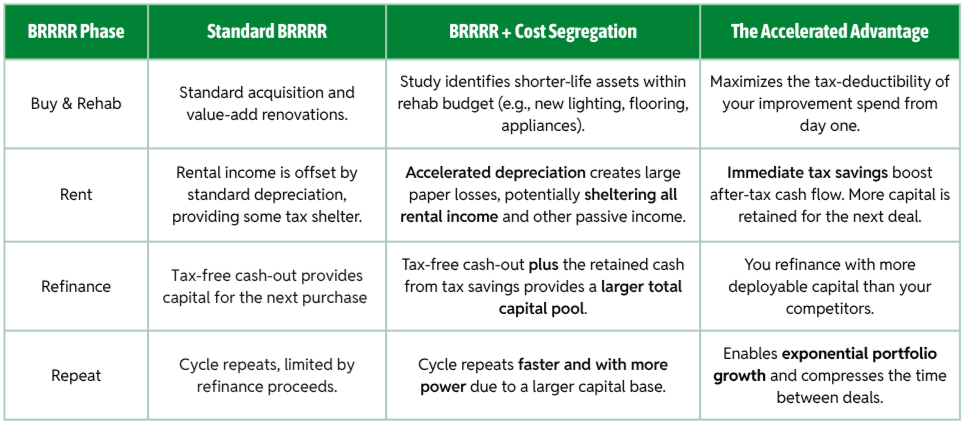10X Your BRRR Strategy with Cost Segregation
Unlock the hidden capital in your deals
|
fund your next acquisition
|
Unlock the hidden capital in your deals | fund your next acquisition |
For sophisticated real estate investors, the BRRRR (Buy, Rehab, Rent, Refinance, Repeat) strategy is a cornerstone of portfolio growth. It’s a powerful cycle for recycling capital, but too many experts hit a ceiling, constrained by the slow pace of traditional capital recycling. The key to breaking through? Integrating cost segregation studies to transform your tax strategy from a passive exercise into an active, cash-flow generating engine.
Pairing these two powerful strategies doesn't just optimize your returns, it fundamentally accelerates the velocity of your capital, allowing you to scale your portfolio at an exponential rate.
The BRRRR Flywheel - Powerful, Yet Incomplete
The BRRRR method is a wealth-building
machine for a reason
By forcing appreciation through strategic renovations and pulling equity out via tax-free refinancing, you can theoretically recycle your initial capital indefinitely. You buy an undervalued asset, increase its value through rehab, stabilize it with a tenant, and then refinance based on the new, higher value. The proceeds from the refinance become the down payment for your next project.
However, this model has a hidden bottleneck: your after-tax cash flow. The speed at which you can move to the next "Repeat" phase is limited by the capital you have on hand after covering expenses and tax liabilities. This is where most investors leave a powerful tool on the table.
Cost Segregation: The Tax Code's Accelerant
A cost segregation study is an engineering-based tax analysis that deconstructs a property into its individual components. Instead of depreciating the entire building over 27.5 or 39 years, it identifies assets that can be depreciated over 5, 7, and 15-year schedules.
5-Year Property: Appliances, carpets, specialized lighting, and certain fixtures.
7-Year Property: Furniture, office equipment, and other personal property.
15-Year Property: Land improvements such as parking lots, landscaping, fencing, and sidewalks.
The real power for BRRRR investors lies in bonus depreciation. Under current law, you can often deduct a significant portion (or even 100%) of these reclassified assets in the very first year the property is placed in service. This creates a massive, upfront paper loss that shelters your rental and other income from taxes.
Strategic Synergy: How Cost Segregation 10x's Your BRRRR
When you inject cost segregation into the BRRRR cycle, you unlock a new dimension of financial efficiency. The accelerated depreciation acts as a turbocharger for your cash flow, directly addressing the primary constraint to your growth.
Imagine, for example, that you acquire a $800,000 multifamily property (with a $200,000 land value). You spend $100,000 on renovations, bringing your total depreciable basis to $700,000.
Without Cost Segregation: Your annual depreciation is roughly $25,455 ($700,000 / 27.5 years). In a 37% tax bracket, this saves you about $9,418 in taxes annually.
With Cost Segregation: A study reclassifies about $154,000 of the basis (from the building and renovations) into 5-year property and 15-year property. Using bonus depreciation, you can write off the entire $154,000 in Year 1 (if placed in service after 01/19/2025).
Year 1 Tax Deduction: $154,000 (accelerated) + ~$16,364 (on the remaining $450,000) = $170,364.
Year 1 Tax Savings (37% bracket): $63,035.
The cost segregation strategy generates an additional $63,035 in immediate tax savings. This isn't a paper profit; it's real cash that stays in your pocket. This is where the 10x multiplier effect comes into play. That $63,035 isn't just a one-time bonus. It's capital that can be immediately deployed.
Cycle 1: Use the $63,035 tax savings to fund the rehab or down payment on BRRRR Property #2.
Cycle 2: You now have two properties generating tax savings and refinance proceeds, funding Properties #3 and #4.
By leveraging this compounded advantage, what took 10 years to accomplish with a standard BRRRR can be compressed into a few years. You're not just recycling your initial capital; you're constantly injecting new, tax-saved capital back into your acquisition engine.
The best time is in the year you place the property in service (after acquisition or post-rehab) . However, you can also perform a "look-back" study on a property you've owned for several years and claim all missed deductions in the current tax year by filing an IRS Form 3115. However, this is not a DIY task. Engage a firm that employs both tax experts and engineers to ensure the study withstands IRS scrutiny. The provider should have a proven track record and certified professionals.
Stop Leaving Capital on the Table
The BRRRR strategy alone is a powerful path to wealth creation. But for the expert investor who understands that true scale comes from optimizing every facet of a deal, integrating cost segregation is a non-negotiable evolution. It transforms the tax code from a complex burden into a strategic partner, unlocking hidden capital within your properties to fuel exponential growth.
You are no longer just recycling your initial investment—you are compounding it with the government's money, breaking through the linear growth barriers and achieving a 10x trajectory.
Do you want to know more about cost segregation? Click here!





